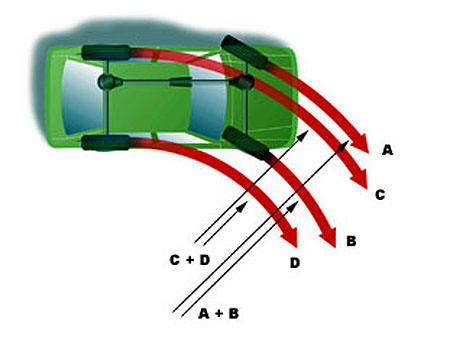© 1996-2008 Harald Pietschmann |
Here is why part time 4WD should not be used on pavement: Different wheel speeds in turns Only when going straight all four wheels are turning at the same speed rate (or at least about the same rate. I'll add a separate page to explain the exceptions) As soon as a turn is initiated all four wheels will rotate at different rates since each of them follows a different imaginary circle. The inside wheels will rotate with less rpm than the outside wheels. The differential on the rear axle guarantees that the rpm delivered via drive shaft from the transfer case are distributed to the left and right wheel as needed. Meaning equal rpm when traveling straight - less rpm to the inside wheel and more rpm to the outside wheel when in a turn. The differential of the front axle does exactly the same thing. The axle differentials take care of the need for different wheel rpm. Interestingly enough during a turn the front axle needs more rpm than the rear axle. Here is why: The front inside wheel will need more rpm than the rear inside wheel. The front outside wheel will need more rpm than the rear outside wheel. This means that the front wheels need more rpm than the rear wheels in a turn When you add the rpm of front wheels (A+B) you will find that the number is higher than the combined rpm of the rear wheels (C+D). Unlike full time 4WD - Part time 4WD is not able to accomodate the need for different axle speeds. Here is why full time can Here is the damage you will have when you use part time 4WD on hard surfaces |
